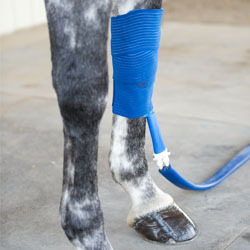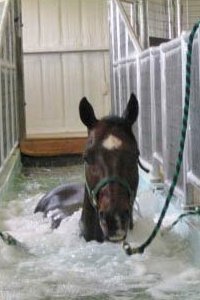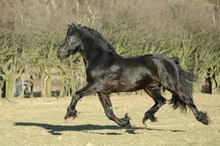As horse owners we try our best to keep our horses healthy, sound, and free from injury. However, horses are animals and sometimes despite our best efforts they sustain an injury. Age, level of competitive performance, and conformation all play a role in a horse's susceptibility to injury.
Adequate turnout with good footing is the biggest home remedy.
Dr. Carol Vischer
Fortunately, the number of non-invasive rehabilitative therapies has dramatically increased. The rehabilitative therapies discussed here are derived from use and success in treating similar injuries and ailments in humans. This list of treatments is by no means all inclusive, but rather an overview of a select few.
In some instances, the therapies can be administered at the horse's home barn, while others require travel to a facility that houses the equipment necessary for treatment. Cost varies based on geographic location and treatment selected.
It is important to remember that the majority of research on the effectiveness of most non-invasive treatments has been conducted on humans. As always, discuss treatment options with your veterinarian and/or farrier prior to administering any type of therapy.
Therapeutic uses of water in various forms
Water is used in a variety of forms to treat and heal injured horses. In its most basic application, hosing a scrape, cut, or wound washes away dirt and debris and reduces the chances for infection.
Taken a step further, cold water therapies can reduce swelling, inflammation, and pain.
"I think icing is underutilized," said Carol Vischer, DVM, of Northeast Performance Equines. "Crushed ice in a bucket of water is great for soaking sore feet. Icing over joints is super helpful."

Cold water therapy to treat a specific equine joint
Systems such as this from Ice Horse circulate near-freezing water to reduce pain and inflammation in the horse's joint.
© IceHorse.net
In particular, Vischer has noted the increased use of systems that incorporate dry cold and compression treatments. Therapies using equipment such as the Game Ready Machine provide alternating dry cold and active compression to treat horses with soft tissue injuries, acute tendon injuries, suspensory desmitis, laminitis, bucked shins, splints, and inflammation, and for post-surgery recovery.
"Ice is analgesic and the alternating pressure helps to move the blood supply and fluids and decrease pain," Vischer added. "A lot of people are using this type of approach after eventing or hard gallops."
Incorporating icing into the maintenance regimen of performance horses can be as inexpensive as investing in a bucket to hold crushed ice and water while the horse stands with its legs in it. Or, depending on the ongoing need, purchasing a machine to provide a combination of dry cold and active compression can cost between $3,000 - $5,000.
Some manufacturers offer rental options for horse owners who could benefit from short-term use of the machine.
Another water-based rehabilitative treatment option is a cold salt water spa. Horses are walked into a unit that fills with water set to 35 - 40 degrees Fahrenheit. A high concentration of salt is mixed into the water and the fluids are circulated by jets built into the unit. Salt increases the benefits of cold water hosing, which includes numbing pain, reducing swelling, and the slowing of degradation of damaged tissues.

Cold water "spa" treatment
Treadmills incorporating a salt bath, such as this from Hydro Horse offer excellent relief of pain and damage from vigorous activities.
© HydroHorse LLC
Horses typically spend between 10 - 20 minutes in a cold salt water spa, but the length of treatments depends on the horse. Specialty rehabilitation centers, such as The Sanctuary: Equine Sports Therapy and Rehabilitation Center in Ocala, Florida or the Morrisville State College Equine Rehabilitation Center in Morrisville, New York provide facilities that have the equipment available.
Swim therapy is another option. Research reviews are mixed at best in regards to the benefits of swim therapy. Some believe it is an ideal method for conditioning an injured horse or a horse in training, while others think it places undue stress on the horse's back and topline.
Treadmills that fill with water have gained popularity because they allow for conditioning/reconditioning without a rider's weight, and because the horse is not submerged in a pool, stress is removed from the topline. "The aqua treadmills are great for building strength," Vischer noted.
Aqua treadmills can be filled to varying depths based on the horse's needs. The water provides buoyancy, which removes the natural resistance on a horse's body and allows for a freer range of motion. These aqua treadmills may be mobile or confined to a specific location, depending on the owner's set-up.
Range of motion treatments
The horse's neck muscles should be soft and pliable. "A rider's instinct is to pull a horse's head down when he raises it up under saddle," Vischer explained. "Pulling the head down rather than lifting from the base of neck and withers causes bracing of the muscles."

Chiropractice and message therapies for the horse
Physical manipulation of the joints and tissues of the horse provide relief from exercise and stress induced pain.
© Carrien Schippers
Braced muscles lead to front and hind leg stiffness. Routine chiropractic care works to increase a horse's normal range of motion and limit abnormal range of motion. "I think that every horse owner should have their horses examined four times a year," Vischer said. "I see horses that are working hard monthly."
In addition to using chiropractic care to improve a horse's range of motion, Vischer suggested horse owners incorporate exercises and stretches that can be done on the ground. "Most don't know how to perform these exercises and stretches, so I teach them."
Light therapy for horse injuries and pain
LED's (light emitting diodes) emit lights of varying frequencies that, when pointed at areas of pain or injury, can increase healing. The red frequency is best suited for injuries closest to the skin's surface such as cuts, scars, and scrapes. Infrared frequencies work better on deep tissue about 30 - 44 mm, specifically for bone, joint, and muscle problems.
"Infrared machines stimulate blood supply and encourage cell growth," Vischer noted. Light therapy increases blood and oxygen supply and stimulates circulation. Among other things, it can also stimulate the release of collagen. Collagen, a natural protein found in the body, repairs damaged tissue and replaces old tissue. Light therapy also stimulates the release of adenosine triphosphate (ATP). ATP carries energy to all cells in the body and helps cells absorb nutrients faster.
"None of it has been proven, but it could work well for some horses," she added.
Oxygen treatments for horses
Hyperbaric oxygen treatments deliver increased amounts of oxygen to injured areas to accelerate the healing process. A horse is placed in a pressurized "stall" and inhales concentrated oxygen.
Atmospheric pressure exerts approximately 14.7 pounds per square inch on our skin and the air we breathe. Normal circulation of oxygen delivery in the body depends on the proportion of oxygen in the air that we breathe, lung function, the amount of hemoglobin in the blood, and the body’s normal blood pressure.
The amount of oxygen that red blood cells can carry is limited by normal atmospheric pressure. When the pressure of the oxygen increases in the hyperbaric chamber, the amount of oxygen being inhaled increases by 10 to 12 times. The pressurized environment allows more oxygen to be dissolved into the blood plasma and consequently more oxygen is circulated to injured tissues.
Breathing treatments are another alternative for horses requiring increased lung capacities. Treatments including pure water vapor (water that is in a gas state) benefits the entire respiratory tract. A treatment of 100% that is inhaled penetrates the entire lung, reaching into the deepest and smallest airways. It works to thin mucous, eliminate mucous plugs, and helps expel excess mucous resulting in less labored breathing.
Posture and turnout are key to horse muscle health
"The biggest thing people do wrong is that they don't appreciate that a horse is constantly bracing it's muscles," Vischer said. "Poor mechanics of movement cause front and hind end injuries."

Turnout alleviates horse stress and improves health
A horse turned-out continously exercises joints and feet increasing strength and flexibility for better health.
Once a horse learns to compensate his way of moving to avoid pain, it becomes ingrained. "Because we can't talk to horses and explain things like we can with people, we have to physically show the horse how to move," she added.
Vischer promotes the use of exercises and stretches to help a horse relax it's muscles and have correct posture. "In general, walking is a great way to strengthen a horse without stress," she added. Start walking on level ground and then incorporate inclines with good footing. Working over poles, incorporating more lateral movement, and backing up all work to improve hind-end strength.
"I am a big fan of turnout. A lot of problems could be mitigated with turnout," Vischer concluded. "Adequate turnout with good footing is the biggest home remedy."
Dig deeperTM
If you found this article useful, you may also enjoy reading the following horse therapy related articles:
